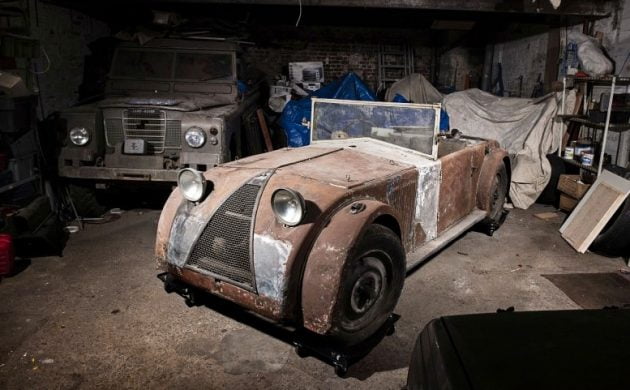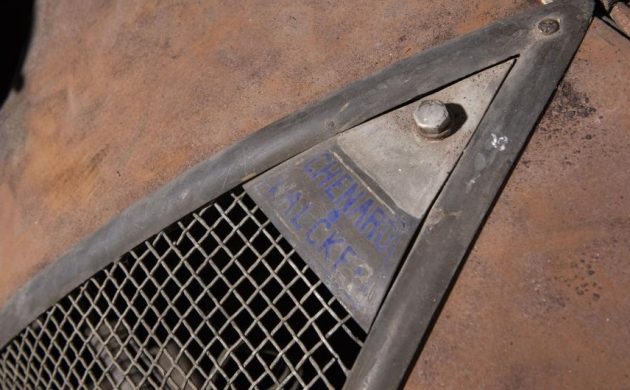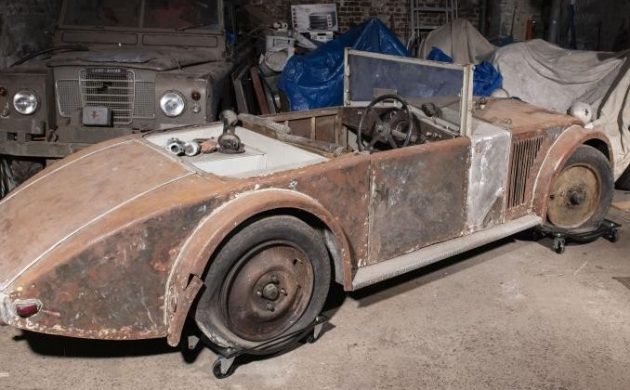There’s probably not an old enamel sign in your garage or hot rod shop emblazoned with the “Chenard & Walcker” logo on it, and there’s a good possibility that this French carmaker’s brand may be coming to your attention for the very first time. This one has been parked in a barn in Brussels but is coming to market here on Artcurial. Thanks to Kyle Knorr for bringing this little gem of auto history to Barn Finds.
There was a time when “superb aerodynamics” in automobile racing meant a car was capable of a ripping top speed of 75 mph from an 1100cc engine–96 mph if it were supercharged. That time was the 1920s, and nearly all passenger cars had wide running boards, arched oak and ash supporting the roof fabric, and wood spoke wheels. Think “Model T” and its 20 hp 177 cubic inch engine capable of propelling the Model T to 45 mph. Chenard & Walcker, car builders in Gennevilliers, France near Paris, were bitten by the prospect of entering a 24-hour auto race called “Le Mans.” They designed and built the car that won the very first Le Mans in 1923 also taking second place with their torpedo-like designs. In 1924, Chenard introduced its “tank” style bodies, evolving into the 1927 Y8 1500 car that we see here.
Chenard & Walcker’s “Y8” eliminated wide running boards, surrounded the wheels with as much metal as possible, slimmed down the tail to better slip through the wind, and made their wheels out of metal, not wood spokes. Race cars of this era weren’t racing on asphalt quite yet, so they were prone to flying road rocks puncturing vital components. The Bentley competitors chasing the Chenard cars in the 1924 Le Mans had to bow out because of rock punctures of its headlights and gas tank. Yes, the Chenard beat the Bentley.
This 1927 Y8 1500 car has been carefully stored since the 1960s by a Belgian collector who passed away before attempting a restoration. Unfortunately, the car has been separated from its engine, though its original three-speed transmission and rear axle remain intact. The auction is November 1, 2020, and is accessible through Artcurial.com. The expectation is that this rare but incomplete car will bring upward of €20-30,000 at auction ($23,650-$35,475). Seems like a very tempting and very scarce piece of auto history for the price range? If you could spend your time restoring a single car, would this be the one?






I love the grill. Never heard of this manufacturer before. It’s an attractive car overall. I hope it’s restored, but good luck finding a motor. Maybe an LS??
LS, well, good choice, maybe 650 HP version? Could get a slight improvement on final track speed with that new engine, thanks for the comment.
Well, I was being sarcastic, but what would someone put in this if the original type motor is NOT available?
How about 16 gerbils on a wheel.
Looks like quite a machine, I would guess if you were in front of this car on a race course you wouldn’t want to see that imposing mug in your mirror that is, if race cars used them in the ’20s). This must have been something in its day.
It does have a meanish “Ma fois!” snarl to its mug, agreed.
I still want it, resting mean face or not.
It’s the closest thing I’ve seen to the winning Pinewood Derby car I made with my daughter about 30 years ago.
Thanks for the comment. And Skorzeny, LOVED the sarcasm. . .I think maybe a lawn mower shop could provide an engine with as much hp and torque as the original C & W powerplant!
Looks like something you would find on Bring a Trailer.
Submitters name check out.
Here’s a model for $20:
https://www.ebay.com/itm/ZT807-IXO-voiture-1-43-Chenard-Walcker-1500-Sport-1929-bleue/254702539883
That model has some rake to the windshield. The one on offer has a windshield that makes it look like they forgot all about aerodynamics above the beltline.
Look at the heavy frame structure you see through the floor area. Tank is a good name. This one is not built to collapse on impact.
They may have been thinking about this kind of “tank” as a reference in 1927
Haven’t tied the use of “tank aero designs” to the Great War death machines, but could be. Scroll down about 1/3rd of the Lombard page – there’s a photo of the two 1927 Lombard AL2 aerodynamic “tank” racing cars and mention that they’re similar to the Bugatti, Voisin, and Chenard et Walker “tank” designs:
https://patrimoineautomobile.com/lombard-1927/
Click on photos to enlarge. Lombard specs are impressive. Two minute video with start up and in action on the track.
The Chenard et Walker le Mans tanks were 1100 cc competition cars and carried far more avant-garde aero bodywork than the production Y8 and. The tanks are more impressive in the “flesh” than in photos as true of many designs. I’m past my “use by” date for restorations so no inclination to buy a project prefering oily-rag or not overly restored cars. The Y8 Tank sold at the February 2018 Retromobile auction hammer price was € 77,480 ($ 94,913).
It may surprise some that there was a New York dealer for Chenard and Walker in the 1930s. Click on the photos on page below to enlarge and read Kissling Motor’s advertising copy, check out pricing and variety of sporting machines on offer in White Plains as shown on this Chenard et Walker page otherwise in French which includes salon photos, muddy road use, and one of the production cars used in competition:
https://chenard-et-walcker.blogspot.com/search/label/Y8
I’ll provide a link to the Artcurial 2018 Y8 sale page in second post.
Love that 1500 cc Coupe, looks very elegant compared to the sporting variant
https://3.bp.blogspot.com/_Wjwvt4Ybl98/SN3mIIxHccI/AAAAAAAAA6o/tiY42A-VEgY/s400/S5300033.JPG Not exactly a large vehicle!
Great insight, James HGF, appreciate the learning. I really only find attraction to the C & W tanks–their other auto offerings are typical coaches of the time. I would like to learn more about C & W’s original rear end gearing, not much hard info I could find. Links very informative.
The 1500 cc cars, Y7 and Y8 tank as above have a 4:25 rear axle ratio which permits a top speed of 80 mph at just under 4000 rpm.
Left out the obvious – the Y7 and Y8 have the same engine and gearing, but the Y8 tank’s aero design makes it more likely to attain or exceed slightly the estimated 80 mph.
The Artcurial 2018 Retromobile auction page in French and English with specifications and more:
https://www.artcurial.com/en/lot-c1930-chenard-walcker-1500-type-y8-tank-no-reserve-3279-323#popin-active
If they were going for aero, perhaps the windshield could have been tilted back a slant. Would love to see in person.
RE: side profile of the scale model of the car. I can’t help but think how much the Chenard racecar from 1929 looks like a Bugeye Sprite from 30 years later!
Cool model. Where can I get one Little_Cars?
It was featured in one of the links provided by “James HGF” or “scott m” above. One of them gives the eBay link.
Looks like a Gumby version of a Bugeye Sprite!
James HGF, thank you for taking the trouble to post the links. They are appreciated.
A 1933 aerodynamic concept for Chenard & Walker by aircraft designer Pierre Mauboussin:
https://coachbuild.com/forum/viewtopic.php?f=81&t=11794
The 1934 Chenard – Walker art deco brochure includes a simple plan drawing that emphasizes the shape of the rear bodywork tapering to a “soft” point at the rear. One off, but fascinating.
This auction has been postponed —-
https://www.artcurial.com/en/sale-4060-automobiles-sur-les-champs-auction-postponed
Could it be we’re seeing an uptick in interest in French cars? I sure hope so…I’m upside down ($$) in the restoration of my Renault Dauphine, but I did not undertake the project to make a buck. Learned a lot during the process!
While it seems to be popular to “beat up on” the French, one has to give credit when it is due as they were (and perhaps still are) very innovative. My Dauphine has “gills” just behind the rear doors to allow air to enter the engine compartment at the rear–which reminds me of a Ferrari Testarossa! The Dauphine also has the cabin heater positioned next to the engine for easy replacement of the heater core…and during the restoration process I noticed it even has a cabin air filter! If I only had the extra space for one more car….
For a guy with a screen name Cobra Steve, I’m surprised to hear you had any interest in a little ol’ Dauphine! Next thing you’ll tell me is you are rebuilding a Crosley — with the C.O.B.R.A. engine.
Let’s just say my taste runs the gamut from small vintage European cars to the more exotic…but cars which I, an Average Joe, can maintain. While so many yield to the temptation to modify, I prefer to enjoy them just as they were originally engineered–with all their quirks.
I bought the Dauphine as I was searching for a car to put my German Shepherds in when going to a classic car event. My old Beetle had two doors and the Dauphine, being 6″ shorter than a Bug, seemed like a logical choice. Only later did I come across a beautiful unmolested Type III VW (Squareback/Variant) which better the pups.
However, with the restoration started on the Dauphine, I had no choice but to forge ahead. The process has been both challenging and rewarding and certainly an education. My patient wife takes comfort knowing where I am in the evening–in the shop. Since I was deemed a one-man hazard on golf courses, and I don’t fish or hunt, it was logical to pursue my passion of 60 years of European cars.
I was curious about the engine specifications. A quick search revealed this. I claim no responsibility for accuracy. It refers to both the Y7 and Y8. “Both versions shared the same engine. This was a totally new four-cylinder unit with 69 mm bore and 100 mm stroke, and Ricardo turbulent cylinder head. The engineer Toutée had designed a very compact engine with lubrication under pressure, oil cooler, overhead intake valves and side exhaust valves, fed by a large Solex carburettor. This was easily capable of reaching 4000 rpm. The gearbox had four forward gears and reverse. The brakes, one of the marque’s strong points, had a diameter of 320mm. The suspension was provided by four pairs of semi-elliptical springs and friction shock absorbers. The published top speed was 135 km/h.”
A good engine choice would be from a Peugeot 403. About 1470cc hemi head from the 1950s. Plenty of engine parts around today.
Wonderful old French car.
Thank you to all you Barn Finder alum for the great research and info!!
Debut of the Autometer shift light. 🤣🤣🤣🤣